Podcast
Questions and Answers
Which of the following is a primary application of radionuclide imaging of the heart?
Which of the following is a primary application of radionuclide imaging of the heart?
- Identifying gastrointestinal blockages
- Evaluating joint inflammation
- Diagnosing neurological diseases
- Assessing cardiac valvular disorders (correct)
Why might a patient trigger radiation alarms at airports following radionuclide imaging?
Why might a patient trigger radiation alarms at airports following radionuclide imaging?
- The imaging process magnetizes metallic implants.
- The patient's body becomes a conductor of electromagnetic waves.
- The imaging causes temporary changes in body temperature.
- Radioactive material is briefly retained in the patient's body. (correct)
What is the key advantage of SPECT over planar techniques in radionuclide imaging?
What is the key advantage of SPECT over planar techniques in radionuclide imaging?
- SPECT provides a two-dimensional image, reducing radiation exposure.
- SPECT uses a stationary camera system for rapid imaging.
- SPECT is rarely used due to its complexity and high cost.
- SPECT produces a three-dimensional image through tomographic reconstruction. (correct)
In myocardial perfusion imaging, decreased uptake of IV radionuclides indicates what condition?
In myocardial perfusion imaging, decreased uptake of IV radionuclides indicates what condition?
How does attenuation affect myocardial perfusion imaging results, and what can cause it?
How does attenuation affect myocardial perfusion imaging results, and what can cause it?
Myocardial perfusion imaging is used with stress testing for what purpose?
Myocardial perfusion imaging is used with stress testing for what purpose?
After a myocardial infarction, what information can myocardial perfusion imaging provide?
After a myocardial infarction, what information can myocardial perfusion imaging provide?
How does radioactive thallium-201 (TI-201) function in stress testing?
How does radioactive thallium-201 (TI-201) function in stress testing?
Why has the use of Tl-201 declined in recent years?
Why has the use of Tl-201 declined in recent years?
What is a key advantage of using technetium-99m (Tc-99m) myocardial perfusion markers over thallium-201?
What is a key advantage of using technetium-99m (Tc-99m) myocardial perfusion markers over thallium-201?
In a 2-day stress-rest protocol, when can the rest imaging be omitted?
In a 2-day stress-rest protocol, when can the rest imaging be omitted?
What is the role of gallium citrate-67 (Ga-67) in radionuclide imaging?
What is the role of gallium citrate-67 (Ga-67) in radionuclide imaging?
What is the primary use of infarct avid imaging?
What is the primary use of infarct avid imaging?
Why is infarct avid imaging rarely used today?
Why is infarct avid imaging rarely used today?
Transthyretin amyloid deposits in the myocardium are particularly avid for which radiopharmaceutical?
Transthyretin amyloid deposits in the myocardium are particularly avid for which radiopharmaceutical?
What is the primary purpose of radionuclide ventriculography?
What is the primary purpose of radionuclide ventriculography?
What has largely replaced radionuclide ventriculography?
What has largely replaced radionuclide ventriculography?
What is a key advantage of first-transit studies in radionuclide ventriculography?
What is a key advantage of first-transit studies in radionuclide ventriculography?
In MUGA, what is the role of the ECG R wave?
In MUGA, what is the role of the ECG R wave?
What is a relative contraindication for MUGA?
What is a relative contraindication for MUGA?
Flashcards
Radionuclide Imaging
Radionuclide Imaging
Imaging using a special detector (gamma camera) after injecting radioactive material to evaluate cardiac conditions.
Single-Photon Emission Computed Tomography (SPECT)
Single-Photon Emission Computed Tomography (SPECT)
A nuclear medicine test using a rotating camera system to create a 3D image of the heart.
Myocardial Perfusion Imaging
Myocardial Perfusion Imaging
Ischemia detection by decreased uptake of IV radionuclides in cardiac tissues.
Attenuation Artifact
Attenuation Artifact
Signup and view all the flashcards
Myocardial Perfusion Imaging Indications
Myocardial Perfusion Imaging Indications
Signup and view all the flashcards
Radioactive Thallium-201 (Tl-201)
Radioactive Thallium-201 (Tl-201)
Signup and view all the flashcards
Technetium-99m (Tc-99m) Markers
Technetium-99m (Tc-99m) Markers
Signup and view all the flashcards
Infarct Avid Imaging
Infarct Avid Imaging
Signup and view all the flashcards
Amyloid Evaluation
Amyloid Evaluation
Signup and view all the flashcards
Radionuclide Ventriculography
Radionuclide Ventriculography
Signup and view all the flashcards
First-Transit Studies
First-Transit Studies
Signup and view all the flashcards
Gated (ECG-synchronized) Blood Pool Imaging (MUGA)
Gated (ECG-synchronized) Blood Pool Imaging (MUGA)
Signup and view all the flashcards
Left Ventriculography (MUGA)
Left Ventriculography (MUGA)
Signup and view all the flashcards
Right Ventriculography (MUGA)
Right Ventriculography (MUGA)
Signup and view all the flashcards
Valve Assessment (MUGA)
Valve Assessment (MUGA)
Signup and view all the flashcards
Shunt Assessment
Shunt Assessment
Signup and view all the flashcards
Study Notes
Radionuclide Imaging
- Employs a gamma camera to image after injecting radioactive material.
- Evaluates cardiac valvular, congenital, and other cardiac disorders, cardiomyopathy, and coronary artery disease (CAD).
- Delivers similar radiation doses as CT scans.
- May trigger radiation alarms in patients for days post-testing due to retained radioactive material.
Single-Photon Emission Computed Tomography (SPECT)
- SPECT is more common in the United States than planar techniques, which produce a 2-dimensional image and are rarely used
- Uses a rotating camera and tomographic reconstruction to produce 3-dimensional images.
- Multihead SPECT systems complete imaging in ≤ 10 minutes.
- SPECT can identify inferior/posterior abnormalities, small infarctions, and vessels causing infarction.
- The mass of infarcted and viable myocardium can be quantified, aiding prognosis.
Myocardial Perfusion Imaging
- Intravenous radionuclides are absorbed by cardiac tissues in proportion to perfusion.
- Areas of reduced uptake indicate relative or absolute ischemia.
- Attenuation from overlying soft tissue may cause false positives and is common in women due to breast tissue.
- Diaphragm and abdominal contents can cause spurious inferior wall defects in both sexes, but more common in men.
- Attenuation is more likely with technetium-99m (99mTc) than with radioactive thallium 201 (Tl-201).
- Used with stress testing to evaluate chest pain, determine the significance of coronary artery stenosis and collateral vessels, assess reperfusion intervention success, and estimate post-myocardial infarction prognosis.
Protocols and Imaging Agents
- Protocols vary based on the imaging agent used.
- Agents include radioactive thallium-201 (Tl-201), technetium-99m (Tc-99m) markers, iodine-123 (I-123)-labeled fatty acids, and I-123 metaiodobenzylguanidine (MIBG).
- Tl-201, a potassium analog, was the first stress-testing tracer, injected at peak stress, imaged with SPECT, and reimaged after a reduced dose at rest, but usage has declined.
- Technetium-99m (Tc-99m) markers include sestamibi (commonly used), tetrofosmin, and teboroxime because the imaging of Tl-201 for the gamma camera is not good
Technetium-99m (Tc-99) Myocardial Perfusion Markers
- Tc-99m sestamibi uptake is slower than thallium but allows flexible timing and immediate imaging for acute symptoms; however, uptake depends on blood flow and low flow areas may be mistaken for scar; studies occur over single or multiple days, and with ECG-gated imaging, ventricular characteristics can be estimated.
- Tc-99m tetrofosmin characteristics are similar to sestamibi.
- Tc-99m teboroxime has high first-pass extraction and rapid washout, making treadmill exercise difficult; studies suggest stress-redistribution testing can be done quickly with pharmacologic stress, and coronary artery disease can be found without stress via myocardial washout analysis.
- Protocols include 2-day stress-rest, 1-day rest-stress, and 1-day stress-rest.
- Dual isotopes (Tl-201 and Tc-99m) are sometimes employed, with sensitivity around 90% and specificity about 71% for detecting coronary artery disease.
- Imaging at rest may be skipped in 2-day protocols if the initial stress test is normal.
- High Tc-99m doses facilitate first-transit function studies with ventriculography for perfusion imaging.
- Other radionuclides include iodine-123 (I-123)–labeled fatty acids, gallium citrate-67 (Ga-67), and I-123 metaiodobenzylguanidine used for research.
Infarct Avid Imaging
- This technique uses radiolabeled markers which accumulate in damaged myocardium.
- Markers include Tc-99m pyrophosphate and antimyosin.
- Images are positive 12-24 hours after acute myocardial infarction and remain so for about a week.
- Seldom utilized now due to the availability of other diagnostic tests for myocardial infarction and because it cannot give any information about the size of an infarct.
- Tc-99m pyrophosphate now assesses cardiac involvement in transthyretin amyloidosis.
- A high uptake ratio indicates transthyretin cardiac amyloidosis, potentially eliminating the need for myocardial biopsy.
Radionuclide Ventriculography
- Evaluates ventricular function, measuring resting/exercise ejection fraction in various heart conditions.
- Replaced by echocardiography due to cost and radiation; however, some doctors prefer this method for the seriel assessment of ventricular function.
- Tc-99m–labeled red blood cells are injected intravenously, and LV/RV function can be evaluated by:
- First-transit studies occur from beat-to-beat
- Gated (ECG-synchronized) blood pool imaging (MUGA) occurs over several minutes
First-Transit Studies vs. MUGA
- Either study can be done during rest or after exercise.
- First-transit studies are faster, but MUGA provides better images.
- First-transit studies image 8-10 cardiac cycles as the marker mixes with blood, ideal for assessing RV function/intracardiac shunts.
- MUGA synchronizes imaging with the ECG R wave, taking multiple images of short cardiac cycle sections over 5-10 minutes, synthesizing a continuous cinematic loop.
- MUGA quantifies ventricular function, including regional wall motion, ejection fraction (EF), volume ratios, and relative volume overload and EF is the most common.
- MUGA during rest has virtually no risk and is used to evaluate RV/LV function, monitor patients on cardiotoxic drugs, and assess CABG, angioplasty, and thrombolysis but arrhythmias are a contraindication.
- MUGA is useful for detecting left ventricular aneurysms.
- Sensitivity and specificity are > 90% for typical anterior/anteroapical aneurysms, but conventional imaging shows inferoposterior LV aneurysms less clearly.
- Gated SPECT imaging takes longer than planar views but shows ventricles better.
Right Ventriculography
- MUGA assesses right ventricular function in lung disorders or when inferior left ventricular infarcts involve the RV.
- RVEF is normally lower than LVEF.
- Low RVEF is common in pulmonary hypertension, RV infarction, or cardiomyopathy affecting the RV.
- Idiopathic cardiomyopathy usually causes biventricular dysfunction.
Valve Assessment
- MUGA with rest-stress protocols assesses valvular disorders causing left ventricular volume overload.
- Aortic regurgitation: reduced resting EF or no increase with exercise indicates deteriorating function and possible valvular repair.
- MUGA calculates the regurgitant fraction of any valve.
- LV stroke volume exceeds RV stroke volume in left-sided valvular regurgitation.
Shunt Assessment
- MUGA and computer programs quantify congenital shunt size via stroke volume ratio or the ratio of abnormal early pulmonary recirculation to total pulmonary radioactivity during the marker's first transit.
Studying That Suits You
Use AI to generate personalized quizzes and flashcards to suit your learning preferences.





